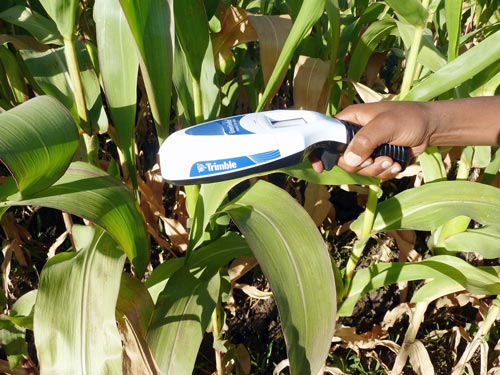By Hae Koo Kim/CIMMYT
A new pocket-sized sensor could bring precision agriculture within reach of smallholder farmers in Ethiopia. Precision agriculture uses data from high-tech observations to assess and address crop variability and help farmers to employ their resources more effectively.

Crop performance readings from satellite or sensor-based technologies are used to “do the right thing, at the right place, at the right time.” Marketed by Trimble since August 2012, the GreenSeeker handheld crop sensor reads near-infrared and red light reflected from plants to measure photosynthesis rates and crop vigor. When used with the normalized difference vegetation index (NDVI), the readings can help farmers decide exactly how much nitrogen fertilizer to apply to get the best yields.
This is especially important in Ethiopia whose soils – like those in many parts of Africa – typically lack nitrogen, a highly mobile element whose availability is affected by rainfall and soil characteristics. At a cost of about US $500, the sensor could make precision agriculture affordable for farmers in Ethiopia. It does not have the accuracy of bigger sensors, but is less expensive and better adapted to smallholder circumstances.
Because most countries in Sub-Saharan Africa import fertilizer, this input is relatively expensive. On average, farmers in the region apply only 9 kg/ha of nitrogen fertilizer, compared to an average 100 kg/ha in South Asia or more than 70 kg/ha in Latin America. This greatly limits their crop yields. When farmers do apply fertilizer, most follow broadly-targeted application rates recommended by extension agents, rather than site- or season-specific rates that would make the best use of this costly input to raise crop yields. CIMMYT agronomists with the Nutritious Maize for Africa (NuME) project, funded by the Department of Foreign Affairs, Trade and Development (DFATD, formerly CIDA) of Canada, have introduced handheld sensors in Ethiopia and are testing them with agronomists Tesfa Bogale and Feyera Merga, from the Ethiopian Institute of Agricultural Research (EIAR), and Ph.D. student Tolera Abera.
 Capacity development
Capacity development 
